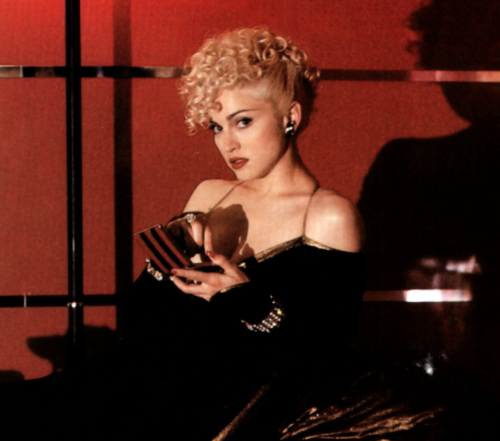Even though, without question, “Vogue” will forever remain the only song remembered by non-Madonna fans from I’m Breathless, it’s more important than ever to recognize the soundtrack’s musical brilliance in the wake of Stephen Sondheim’s death. Because only could this particular lyricist manage to bridge the gap between Broadway and a comic strip movie. Granted, one that was just about as gay as you could get—not merely because Dick Tracy was a dandy (whose name is Dick)—but, obviously, because Madonna had already established herself as the gay icon now attached to the project. So naturally, Sondheim wanted to further amplify the homo cachet by joining in on the fun.
Because of Madonna’s persona in the film, Breathless Mahoney, being a showgirl, it was only right to ask the King of Show Tunes himself to contribute a few numbers. And perhaps he was most amenable because Warren Beatty seemed to be able to call in a favor from every crony in the book to get this “picture” made. Sondheim could have easily been allured by an all-star cast that also included Al Pacino, Dustin Hoffman, James Caan, Kathy Bates, Dick Van Dyke and Paul Sorvino. Even though, for the most part, all of these characters were rendered practically unrecognizable due to their prosthetic makeup.
Around the release of the film and its synergistic soundtrack, Madonna commented, “I want people to think of me as a musical comedy actress. That’s what this album is about for me. It’s a stretch. Not just pop music, but songs that have a different feel to them, a theatrical feel.” Yes, thanks in part to Old Stevie Boy. Who also helped M secure an Academy Award for “Sooner or Later”—which she famously performed at the ceremony in full Marilyn Monroe drag (never say she hasn’t been the woman most committed to emulating this OG twentieth century icon). But, as anyone knows, Madonna is nothing if not in control, which is why she co-produced all the Sondheim ditties, including “Sooner or Later,” “More” and “What Can You Lose” (featuring none other than Mandy Patinkin for added theater clout).
With “More” acting as something like a sequel to “Material Girl” (and a far greedier and more elaborate one at that), Madonna was already well-versed in how to convey her lust for cold, hard cash and all the things it could get her. Indeed, it was only recently in her Madame Xtra Q&A that she was asked by Billie Eilish, “What is your favorite scent?” to which Madonna replied, “I was thinking about money.” Can’t keep a capitalistic girl down, one supposes. Luckily, Madonna has always known how to merge art and commerce (perhaps even invented the practice in its modern-day form). As such, she still knows how to convey emotion when the moment calls for it—as it does on “What Can You Lose.” A quintessential torch song, Patinkin, who plays the piano player, 88 Keys, in Dick Tracy, sings it to an oblivious Breathless, urging him to confess his feelings in her portion of the lyrics, yet not fathoming—or caring—that 88 Keys could have any for her. And, well, since he does, she might as well use it to her advantage.
Sondheim was also enlisted to write “Back in Business” (later credited to longtime Madonna collaborator Patrick Leonard) and “Live Alone and Like It” (a song that could be most people’s theme these days). The latter never made the soundtrack’s cut, though it did appear in a 1992 Sondheim showcase called Putting It Together.
With Madonna determined to fully embody the showgirl persona (hip-hugging, curve-accentuating gowns included), Sondheim was an undeniable must for her to feel as though she had all that she needed to completely transcend into Breathless. And oh, how she did. The audience, however, was duly forewarned that, sooner or later, they were going to be hers. Putty in Breathless’ hands (thanks to Stephen’s lyrical contributions).






















